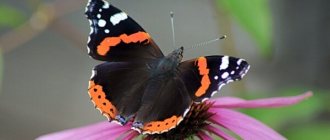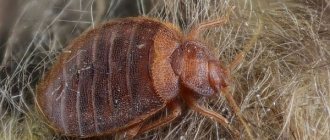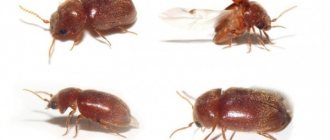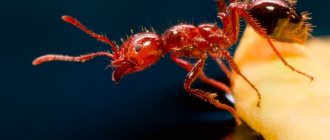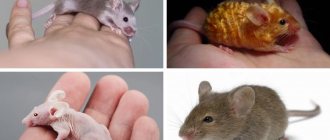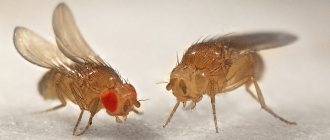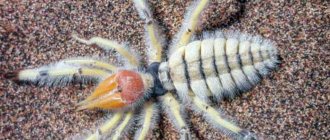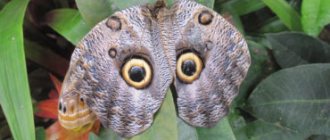Hawkmoth is a butterfly that looks like a hummingbird. She seems to be hovering over the flowers, quickly moving her wings. The colors of the representatives of this family are so diverse and original that it may be difficult to immediately guess which insect is in front of you. One of the main distinguishing features of the hawk moth is its long proboscis, which most often exceeds the size of the insect’s body. A video of the development of the caterpillar will be at the end of the article.
This unusually colored butterfly is a frequent hero of horror films and books. Why do superstitious people feel real trepidation at the sight of a small insect, and should summer residents who discover a hawkmoth pupa fear for their harvest?
In total, about 1,200 species of such butterflies are known, some of which are listed in the Red Book . In Russia you can see 50 species. How to understand that this is a hawk moth in front of you? Should you be afraid for the harvest if you find an uninvited guest at your summer cottage?
Origin of the species and description
Photo: Hawk Moth Butterfly
The hawk moth butterfly is an arthropod insect, classified in the order Lepidoptera, the hawk moth family. The name of one of the most famous subspecies of the hawkmoth subspecies is death's head. This is explained by the fact that on the outer surface of the head there is an image resembling the shape of a skull. This butterfly is the hero of many mythical tales and beliefs.
The scientist Heinrich Prell studied the species and described it in the 20th century. This type of insect has always aroused unprecedented interest. In ancient times, these butterflies were considered messengers of misfortune and signs of failure and disease. People believed that if this insect suddenly entered a human home, then death would soon come here. There was also such a sign: if a piece of a wing gets into the eye, then the person will soon go blind and lose his sight.
Video: Butterfly Hawkmoth
In zoological atlases, the hawk moth butterfly is found under the name Acherontia atropos. Translated from Latin, the name of this butterfly symbolizes the name of one of the water sources of the kingdom of the dead. Initially, zoologists believed that butterflies appeared on earth after the appearance of flowering plants. However, this theory was not subsequently confirmed. Establishing the exact period of appearance of butterflies on earth is problematic. This is due to the fact that Lepidoptera have a fragile body.
Findings of the remains of ancient ancestors of modern butterflies are very rare. They were mainly found in pieces of resin or amber. The most ancient finds of the ancient ancestors of modern Lepidoptera date back to 140-180 million years ago. However, scientists claim that the first primitive butterflies, resembling moths in appearance, appeared on earth a little over 280 million years ago. This type of butterfly is divided into a huge number of subspecies, each of which has its own distinctive characteristics.
Hawkmoths in culture
For superstitious people, meeting a hawk moth is a frightening event. A butterfly called "death's head" has become the heroine of creepy legends and stories. This insect has been blamed for disease, death and even war. Some beliefs are still alive - the Mexicans believe that if a scale from a hawk moth's wing accidentally gets into the eye, you can even go blind.
Mentions of the scary butterfly can be found in books and films. So in the film “The Silence of the Lambs” by Jonathan Demme, a maniac puts a hawkmoth pupa into his victims’ mouths. In the novel on which the film was based, a different species was chosen - Acherontia styx, but in the film we see the death's head hawkmoth.
Edgar Poe mentions this butterfly in the story “The Sphinx” - where the insect was crawling along the web on the window. Alexander Belyaev refers to the same creepy image in the story “The Death's Head”.
Van Gogh called one of his works “Death's Head Hawkmoth.” However, he mistakenly depicted another butterfly, called the Pear-Eyed Peacock. A new name was given to the painting at the Artist's Museum in Amsterdam, renaming it “Imperial Night Butterfly”.
Appearance and features
Photo: Hawkmoth butterfly similar to a hummingbird
Hawkmoths are considered relatively large insects and have characteristic features.
Signs of this type of lepidoptera:
- massive body;
- long thin wings. In this case, the front pair of wings is much longer than the rear pair. At rest, most often the lower pair of wings is hidden under the lower one, or they are folded in the shape of a house;
- antennae without round beads at the end;
- the body has a characteristic pattern that resembles tree bark.
The wingspan of these butterflies ranges from 3 to 10 centimeters. The body length is 10-11 centimeters. This species of Lepidoptera exhibits sexual dimorphism. Females are slightly larger than males. The weight of one adult female is 3-9 grams, male – 2-7 grams.
Size, body weight and color are largely determined by the subspecies. For example, the largest representative of this species is antheus. Its wingspan is 16-17 centimeters. The smallest is the dwarf hawk moth. Its wing span does not exceed 2-3 mm. Wine hawk moth has a characteristic dark red hue. Color is also largely determined by region of habitat and diet.
The butterfly has antennae that can be of varying lengths, spindle-shaped or rod-shaped. They are pointed and curved upward. In males they are much wider than in females. The oral apparatus of the hawk moth is represented by an elongated, thin proboscis. Its length can be several times the size of the body, and reaches 15-17 centimeters. The Madagascan hawk moth has the longest proboscis; its length exceeds 30 centimeters. In some subspecies it is short or underdeveloped. During the period when butterflies do not eat, it is simply rolled up into a tube.
On the lips of butterflies there are rather developed palps, which are curved upward and covered with scales. The insect has rather complex, large round eyes. They are slightly covered with shaggy eyebrows. Special infrared locators are built into the organs of vision. With their help, insects not only distinguish colors, but are also able to capture infrared invisible rays. The body of the insect is covered with rather dense, thick fibers. At the end of the body, the villi are collected into a brush or braid. Insects have fairly developed pectoral muscles, thanks to which they can develop high flight speeds.
Where does the hawk moth butterfly live?
Photo: Hawkmoth butterfly in nature
This species of Lepidoptera is a heat-loving insect. Despite the wide variety of subspecies, most of them are concentrated in tropical countries. Some subspecies can be found in the temperate zone of the earth.
Butterfly habitat:
- North America;
- South America;
- Africa;
- Australia;
- Russia;
- Eurasia.
No more than fifty subspecies live on the territory of Russia. Most butterfly species choose areas with dense vegetation as their habitat. However, there are subspecies that inhabit the desert regions of Eurasia. Most species of hawk moths are considered moths. Therefore, during the day they are mainly found on the bark of trees and bushes.
Hawkmoths are cold-blooded insects, so before flying they flap their wings for a long time and quickly, heating their body to the desired temperature. In the tropics, hawk moths fly all year round. In temperate latitudes they survive winter in the pupal stage. To survive in the oncoming cold weather, the pupa hides in the soil or moss.
Some species migrate with the onset of cold weather to warmer countries. There are species that, on the contrary, migrate with the onset of summer to more northern regions. Migration is associated not only with climate change, but also with overpopulation of the habitat. In new regions, they create temporary colonies and breed offspring.
Now you know where the hawk moth butterfly lives, let's find out what it eats.
What does the hawk moth butterfly eat?
Photo: Hawk Moth Butterfly
The main source of nutrition for adults is flower nectar, which is rich in carbohydrates. Due to the fact that the lifespan of a butterfly is very short-lived, it accumulates its main source of proteins during the period it is in the form of a caterpillar. Depending on the species and stage of development, Lepidoptera prefer to feed on the nectar of various plant species.
What can serve as a food source:
- poplar;
- sea buckthorn;
- lilac;
- raspberries;
- dope;
- belladonna;
- fruit trees - plum, cherry, apple tree;
- jasmine;
- tomatoes;
- nectar of coniferous plants;
- grape;
- spurge;
- oak.
Interesting fact: The tobacco hawk moth larva is considered poisonous, as it feeds on tobacco leaves and accumulates toxic substances present in the plant. It has a specific coloring that scares away birds of prey, and can also butt, spit, and make specific sounds.
There are also species of hawk moths that are able to feed on honey by climbing into hives. Surprisingly, the insect manages to feast on sweets and remain completely unharmed. They are capable of making sounds reminiscent of a bee buzzing. A strong proboscis helps to pierce honeycombs without difficulty.
Hawkmoths have a peculiar feeding style. They hover over the plant and use their long trunk to suck up sweet nectar. It is noteworthy that no other insect has this ability. With this feeding method, insects do not pollinate plants.
Features of character and lifestyle
Photo: Hawkmoth butterfly in flight
In nature, there are a huge number of subspecies of hawk moth. Each subspecies is characterized by activity at different times of the day. There are hawk moths who prefer to lead a nocturnal, diurnal or twilight lifestyle. These types of butterflies tend to develop high flight speeds. During the flight, they make a characteristic sound reminiscent of the drone of an airplane.
Interesting fact: High flight speed is ensured by rapid flapping of the wings. The butterfly makes more than 50 strokes per second!
Some butterflies resemble small birds in appearance. They are capable of covering vast distances, flying from one end of the country to the other, or even from continent to continent.
These types of butterflies are characterized by a specific feeding style. Due to its rather large weight, not every flower can support a butterfly. Because of this, they hover over the plant and use their long proboscis to suck out nectar. She flies from one plant to another until she is completely satiated. After the butterfly satisfies its hunger, it flies, swaying slightly from side to side.
Some species of hawk moths, including the “death’s head”, at the moment of approaching danger, emit a characteristic sound reminiscent of a loud squeak. They are able to make such sounds thanks to the air that is released from the foregut, which contributes to the vibration of the folds of the oral apparatus.
Interesting facts about hawk moths
Hawk Moth is distinguished not only by its bright and memorable coloring. Some facts about this insect are amazing:
- The death's head butterfly is a real intruder in the world of insects. The hawk moth robs the bees - it flies up to the hive and begins to buzz characteristically, then pierces the honeycomb with its proboscis and feasts on honey. But sometimes the bees understand the trick, pounce on the robber, bite him to death and then mummify him in the hive.
- Another feature of the species is that in times of danger it begins to squeak loudly and desperately.
- In a minute, an insect can cover a distance that is 25 thousand times greater than its body.
- In the Middle Ages, the lilac hawk moth was terribly feared because it was considered a harbinger of death.
- From Latin the name of the wine hawkmoth (“porcellus”) is translated as “piglet”. From a distance, the insect appears to be completely pink.
Social structure and reproduction
Photo: Hawkmoth butterfly from the Red Book
In their natural habitat, butterflies breed throughout the year. Offspring are hatched twice, sometimes three times under favorable climatic conditions. Mating most often occurs in the dark. It lasts from 20-30 minutes to several hours. Throughout this entire period, the insects remain motionless.
At one time, one female individual is capable of laying up to 150-170 eggs. The egg is round in shape and has a white color with a blue or green tint. Eggs are most often laid on forage vegetation. Subsequently, after 2-4 days, a light, milky-white larva with colorless legs appears from the eggs.
The caterpillar has several stages of development:
- the caterpillar is light green in color, the diameter of the caterpillar does not exceed 12-13 millimeters;
- a large brown horn is formed on the body, the size of which visually exceeds the size of the body;
- the caterpillar increases significantly in size, new signs appear;
- the formed horn becomes lighter and rougher. Stripes and dark spots appear on segments of the body;
- the size of the body increases to 5-6 centimeters, weight reaches 4-5 grams;
- the larva increases significantly in size. Weight reaches 20 grams, length – up to 15 centimeters.
Caterpillars are perfectly adapted to survive in various conditions. Depending on the species, they have a camouflage coloring that allows them to blend in with the vegetation. The caterpillars of some species have a streamlined shape, stiff bristles, or may emit an unpleasant odor that repels birds and other representatives of the animal world that eat the caterpillars.
After the caterpillar has accumulated sufficient nutrients and gained sufficient body weight, it sinks into the soil. There she pupates. At the pupal stage, the butterfly exists for 2.5-3 weeks. During this period, great changes occur in the body of insects. The caterpillar transforms into a butterfly. The beautiful butterfly frees itself from the cocoon, dries its wings, and goes in search of a mating partner in order to continue its life cycle.
Eggs
So, we raised the purchased caterpillars, waited for pupation, and the butterflies hatched. Now comes the fun part – the eggs).
The butterfly begins to lay eggs immediately on the first night. But whether they will bear fruit or not depends on whether the females have eaten, whether the males have eaten, and whether there was mating at all.
One female can lay 50 pieces in her short life, but I won’t tell you the maximum number. I had 6 females and they dropped 3000 eggs and dropped more, but I didn’t count anymore. It turns out that one put aside, roughly speaking, 500 pieces. I collected from 400 pcs per day. I put 100 eggs in sauce boats and signed the quantity and date. The babies began to hatch on the third day after the “harvest” was collected, and not a single egg collected on the first day turned out to be a fertilization. Like this.
Butterflies begin their flight every evening with dinner, and then begin to lay eggs. Because my feeder stood in the middle of a pot of peppers, they combined business with pleasure, ate and immediately “molded” eggs under the leaves of the plant. And not only. Both on the feeder and on the slats of the flexarium. In general, wherever their heart desires. It was easier for me to collect eggs from pepper leaves. During the day, while the butterflies were resting, I took out the pot and calmly collected it, because... the main part was there.
I incubated the eggs directly in small sauce boats at a temperature of 23-25C. Direct sunlight and strong moisture should be avoided. It would be a good idea to make holes in the gravy boats for ventilation. The babies emerge 2-4 days after collection. I didn’t put anything on the bottom of the gravy boats. Remove from the leaves and simply place on the bottom. The volume of the gravy boat is maximum 80 ml, less is possible.
The color of the eggs varies from bright green to green-yellow. Round in shape, about 1 mm in diameter. Quite dense, when collected, they can be damaged with strong pressure.
By the way, you can buy not only caterpillars, but also eggs. It turns out cheaper, but! hatching percentage is a surprise. How was it collected, when was it collected, at what temperature was it incubated? If I'm not mistaken, they sell eggs in quantities starting from 50 pcs. And, if you take into account the hatching speed (2-4 days), the babies will start hatching right on the road, if you suddenly decide to order by mail or some other way. And then the % loss will be even higher. The option to buy eggs is good for those who can pick them up directly from the store.
Natural enemies of hawkmoth butterflies
Photo: Hawk moth
The hawk moth butterfly has quite a few enemies in its natural habitat. At every stage of their development, they are constantly surrounded by danger and serious threats. The main enemies are parasites. These include wasps, wasps, and other types of parasites. They lay eggs on the surface of the body of butterflies, caterpillars or pupae. Subsequently, parasitic larvae emerge from the eggs and feed on the internal organs of the butterflies, causing their death. Only when fully formed do the parasite larvae leave the body of the butterflies.
Birds pose a danger to butterflies. For many species of birds, the main source of food is caterpillars, or even butterflies themselves. However, not all bird species are capable of catching such a dexterous and fast insect. Humans play an important role in exterminating the number of insects. As a result of its activities, it uses chemical insecticides and destroys the natural habitat of lepidopterans.
Use of tobacco hawkmoth
Butterflies and caterpillars have found application in two areas: scientific and biological. They are used as subjects for experiments and as food for pets.
Model organism for research
Due to its significant size, rapid development and easy maintenance, the tobacco hawk moth has become a popular model organism. With its help, scientists study the properties and processes of living nature. The insect is especially widely used in neurobiology. The larvae are easily opened, their organs are separated without problems. For breeding, eggs are taken, washed in a disinfectant solution. They are placed on the leaves of food plants or artificial substitutes.
Caterpillars are food for reptiles
Fans of exotic reptiles breed tobacco hawk moth caterpillars as food for their pets. The body of the larva contains calcium, protein and moisture necessary for the full development of reptiles. In the warm season, the caterpillars are fed with leaves of nightshades: tomatoes and potatoes. In winter, they provide special food based on wheat germ. Adult larvae up to 10 cm long are suitable for large reptiles; smaller specimens are purchased for small lizards. When keeping caterpillars, it is necessary to maintain the humidity regime. The lack of free access to water will lead to their dehydration.
One caterpillar replaces 3 locusts in nutritional value; the undoubted advantage of the species is the absence of a hard chitinous shell. For breeding, larvae are purchased in special plastic boxes with mesh. Pet stores sell special food that is diluted according to instructions. Before pupation, coconut substrate is poured into the container, into which the caterpillar will immediately burrow. The soil is periodically moistened. Butterflies will need a larger container, a plant to sit on during the day, and honey syrup for nutrition. After mating, females lay eggs and soon die; males live for another 2 weeks.
Population and species status
Photo: Hawk Moth Butterfly
Despite the diversity of species, the hawk moth is listed in the Red Book, and many species of this butterfly are in the regional Red Books. Today, the total population of the insect is considered not to be endangered. It is even excluded from the Red Book of the Russian Federation. On the territory of Ukraine, the number remains threatening. In connection with this, it was assigned the third category, and it is listed in the country’s Red Book.
Various factors contribute to the decline in hawk moth populations in different regions:
- increase in the number of birds;
- treatment of forage crops with chemical insecticides;
- cutting down bushes and burning grass;
- human development of the habitual habitat regions of hawk moths.
A more favorable situation with the number of insects in the Transcaucasus. The climate here is milder, so many more pupae are able to survive the winter period.
In other regions, mass deaths of pupae and larvae are observed due to the treatment of vegetation with chemical insecticides to bait the Colorado potato beetle. Also contributing to the decline in numbers is the large number of birds for which caterpillars are the main source of food.
